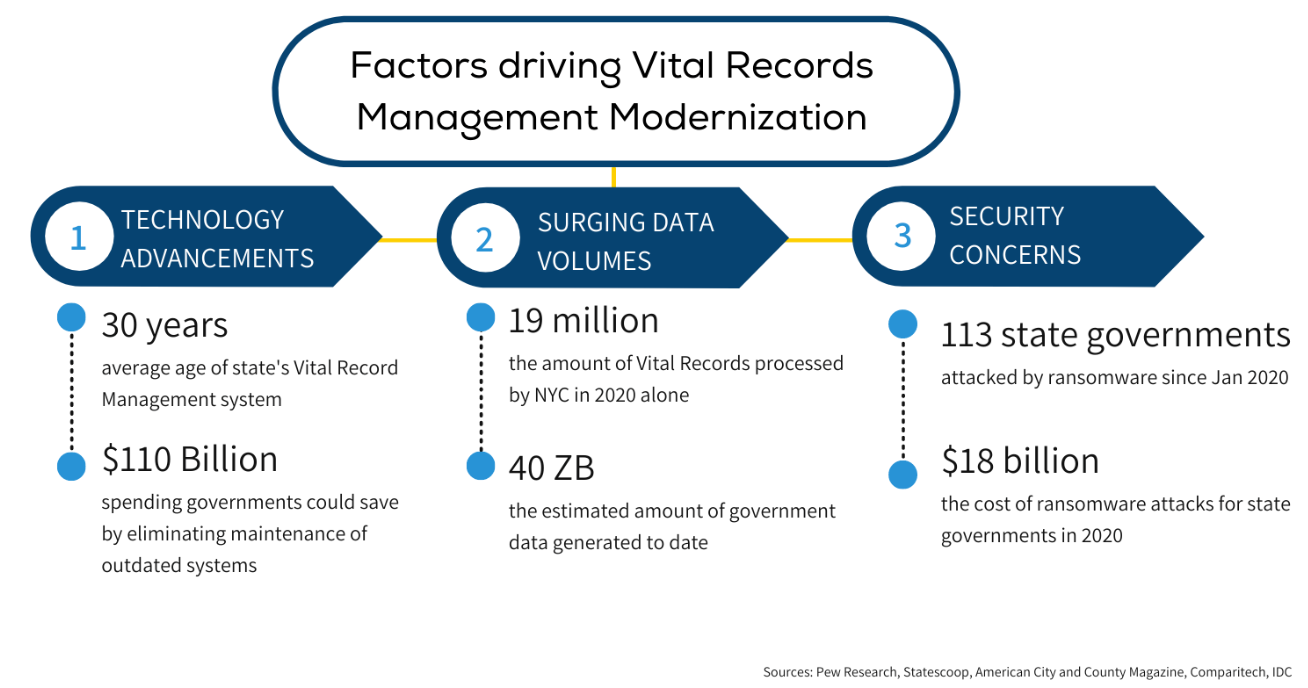What’s Driving Vital Records Management Modernization?
What’s Driving Vital Records Management Modernization?
For state CIOs nationwide, modernization is one of the top five priorities—hardly a surprise considering 75% of IT spending has historically been dedicated to maintaining legacy government systems. While legacy systems cost the government millions every year, outdated vital record management systems (VRMS) pose more than a financial risk for state and local governments. When faced with a public health emergency, processing vital records quickly and accurately is a mission-critical component of an informed, effective response.

COVID-19 spotlighted the role of vital health records in a public health emergency. The scalability of death reporting systems was put to the test, and local governments relied on timely, accurate data releases to communicate the urgency of the pandemic to the public.
Unfortunately, many state VRMS are more than 30 years old and unable to meet the needs of an increasingly mobile, digitally engaged constituency. A substantial shift in the way local and state governments manage their VRMS can not only help agencies build resiliency in the face of disasters, but also establish numerous benefits, from cost savings to improved security.
New IT modernization methods and tools will include enhancements like cloud computing, cognitive solutions, and agile solution development. At the same time, modernization can improve efficiency, cybersecurity, and bring cost savings to cash-strapped agencies. Let’s take a look at a few of the leading drivers of modernization of vital records management modernization at the state and local level.
A Shift Toward Digital Government
Residents are accustomed to interacting with companies and organizations digitally: banking shopping, healthcare, and even education have been modernized to include a digital component. Residents expect the government to do the same. In fact, 57% of Americans believe technology will improve the way they engage with government services. That includes the acquisition of vital records like birth and death certificates. With modernized VRMS, public sector employees and residents can simply log into a portal or mobile app to request or access vital records.
Increased Need for Interoperability
Interoperability speaks to the ease at which different systems pass information to each other. VRMS must interact with numerous parallel systems, including surveillance systems that monitor drug overdose deaths, the national cancer registry, the National Vital Statistics System – and that’s just to name a few. Naturally, it’s crucial to make sure those systems can work together seamlessly, the result of which can help streamline services and inform potentially life-saving insights by generating nearer to real-time data on opioids, suicide, cancer, and all causes of death.
Increased Efficiency
Modernization would make the enormous volume of data related to vital records more usable for state agencies. New York City’s Bureau of Vital Statistics (BVS) saw this increase in efficiency when they implemented a next-gen system called eVital. BVS had previously been confined to an outdated, hardware-based biometric system that allowed users to certify cases only after submitting fingerprints to a dedicated, on-site computer. eVital successfully integrated department systems, while boasting a mobile-friendly platform that used facial recognition instead of fingerprints. This allows users to certify cases remotely, without the burden of having to be physically at a specific terminal.
Improved Cybersecurity
In August 2021, the city of Joplin, Missouri was hit by a ransomware attack. The city’s COVID-19 dashboard, court functions, and online utility payments were all affected. While steps were taken to rebuild these services promptly, Joplin also engaged with a third-party IT forensics firm to find out what data was accessed. The answer? The city’s birth and death records. With attacks like these becoming more prevalent, it is clear that vital records don’t just need to be better managed and organized; they need to be protected.
BVS, for example, has taken steps to prioritize the security of its VRMS by utilizing facial recognition to establish a more trustworthy authentication process. Not only did this institute a secure process, but it also improved authorized users’ ability to certify cases remotely and more quickly than before.
The bottom line is that vital records management is an important but far too often overlooked part of state and local governance. Modernization can drive the adoption of new technologies that can better citizen experience, enhance interoperability, and improve cybersecurity. At the same time, it can help eliminate redundant, outdated, and expensive solutions. For state and local agencies, there’s simply no reason to wait. The time to start modernization of vital records management is now.
-Voyatek Leadership

